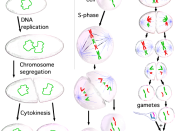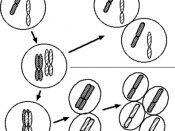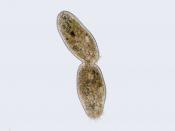Mitosis and meiosis have several similarities and differences. In mitosis, cells divide in four steps. First, they go through prophase. In prophase, the centrioles begin to move apart from each other toward opposite poles and the nuclear membrane begins to breakup. In metaphase, chromosomes lineup at the equator of the cell, known as the metaphase plate. In anaphase, the centromere that connects the chromatids splits and the chromatids separate from one another. The chromatids move toward opposite ends of the cell. In anaphase, the cell also starts to split in two, forming a cleavage furrow, the area where it pinched apart. In telophase, a nuclear membrane forms around each new cell, resulting in two daughter cells. The cytoplasm then begins to divide, called cytokinesis.
The difference between mitosis and meiosis I is the pairing up of homologous chromosomes in a process called synapsis in meiosis I. Because of this, this drastically changes the processes of meiosis.
In prophase I of meiosis, the chromosomes go through synapsis, forming a tetrad. Everything else that happens in prophase happens. In metaphase I, the chromosomes line up at the equator of the cell, but, they stay in their homologous pairs. During anaphase I of meiosis, the centromeres do not divide. Instead, the homologous pairs separate with the entire replicated chromosome moving to the opposite poles of the cell. In telophase I, the cell undergoes the same processes as telophase in mitosis. But, instead of 23 homologous pairs of chromosomes, there are now 23 replicated chromosomes. Meiosis II is virtually the same at mitosis, but each cell has only 23 replicated chromosomes instead of 46. After the cells go through telophase II, we are left with four haploid cells.



Good Detail
A lot of info provided in a very short essay. Good job.
1 out of 1 people found this comment useful.